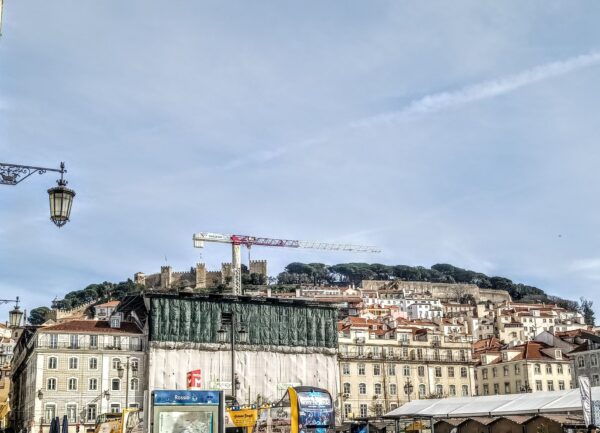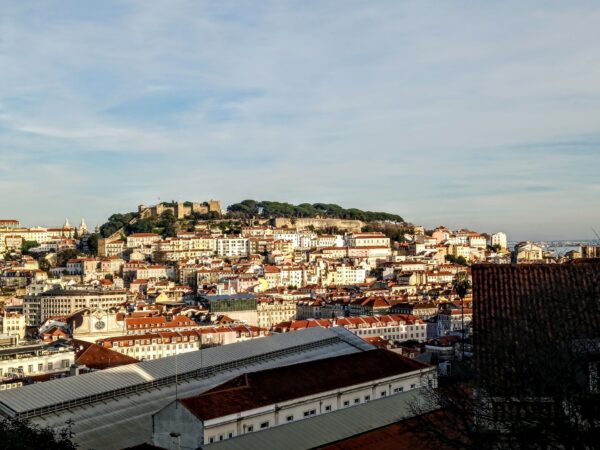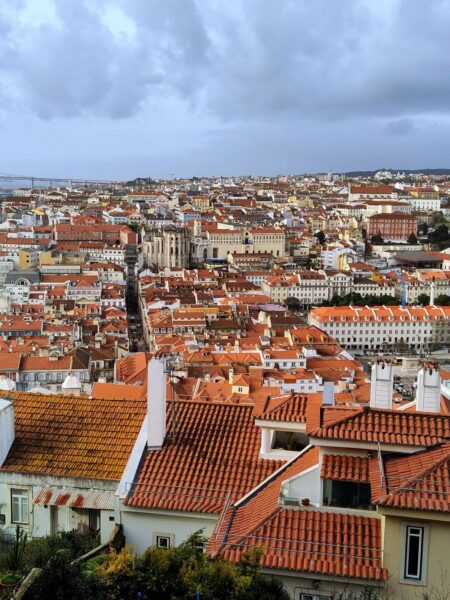Castle on a Cloud.
While it might not be on a cloud, there are few places you can go in Lisbon’s core where there’s open space and not at least sense the looming presence of the Castelo de São Jorge. Whether it’s from Praça da Figueira,

or the Miradouro de São Pedro de Alcântara,

it’s often in the line of sight. And even when it’s not, you can somehow sense its presence.
It looks very old (and parts of it are) so it’s only natural that people want to visit it and this was certainly true for my family and particularly for my grandnephews. My general approach to their visit was that their vacation belonged to them and my role was to act as a facilitator when needed and as a guide when appropriate. In my role as the former, I hoped to help them make choices based on the available time and, to a lesser degree, the weather. And, it was the combination of a lovely morning and a timed activity for late in the afternoon that made Saturday the appropriate day to visit Saint George’s Castle.
I realize I’m once again breaking my promise to keep to my new Lisboa experiences and that I have previously written about visiting the Castelo but I want to share a little of their experience. With my vow in mind, I’ll keep this section brief.
As my sister noted in her diary, the day was sunny and fairly warm and “there are fabulous viewing points along the perimeter” of the castle such as this one I took on my previous visit.

As it turns out, delaying this visit until later in the trip had certain advantages in that it allowed me to see how much of an impression the trip was making on my grandnephews. As we stood looking at some of those “fabulous views”, each of the boys was able to identify several of the places they’d visited. It also gave them a sense of how compact the old city is. It was fun and enlightening for me to see it through their eyes and is why I deemed it worth mentioning.
Graceful men lift lovely girls.
Okay. I’ve been to the ballet. In fact, I think all five of us had seen at least one ballet live in a theater. What none of us had done was see a ballet in Lisboa. In fact, while I had seen Mozart’s opera Le Nozze di Figaro in Saint Petersburg, I’m not certain any of us had seen a ballet at any venue in Europe. Thus, hoping to give my grandnephews a well-rounded experience, we decided to try to include some high culture when we were planning the trip. It turned out to be a matinee (16:00) performance of Tchaikovsky’s Swan Lake at Lisbon’s Coliseu dos Recreiros.

Why Swan Lake and why this performance you might reasonably wonder. I can provide a general answer in a few words: trip activity scheduling limitations, ticket availability, and proximity.
As I’ve noted elsewhere, we wanted to keep as much flexibility as possible for the two week duration but some elements required advance planning. These included the New Year’s Eve cruise, the trip to Sintra, and the overnight in the Algarve. Because it fell on Monday, New Year’s day was a sort of double whammy. Additionally, although not pre-scheduled, I’d been given a “damn the torpedoes” order from my sister to procure tickets to at least one futbol match. In the planning stage, this eliminated two more days because I had to keep open a chance to see both Lisboa clubs.
Once I started looking at dates, it became apparent that this ballet was the best choice from the range of available shows and because the Coliseu was only about a half kilometer mostly flat walk from where we were living. I chose the afternoon performance because the day’s second show was scheduled to begin at 21:00 and that seemed too late for most of us. Fortunately, I’d scheduled this far enough in advance that purchasing tickets was the easiest part.
Swan Lake is, as Howard Posner calls it in an article for the Hollywood Bowl, “the ballet, the source of the visual cliches that say “ballet” to the non-ballet public.” My sister had seen it several times – at least twice with Mikhail Baryshnikov dancing the role of Prince Siegfried. (As “the ballet”, every prominent male and female dancer has danced the roles of Siegfried and Odette/Odile.) While our cast was capable, we certainly didn’t see the quality of dance that a Nureyev or Fonteyn would bring to the stage. In fact, I thought the fellow who danced the part of Benno (Siegfried’s friend) brought the most energy to his performance.
Curiously, and I assume to save the cost of mounting a full scale production, there was no live orchestra. It was the first time either my sister or I could remember seeing a ballet with a pre-recorded score. It was, at times, a little disconcerting. She also noted that the “happy ending” we saw in which Siegfried and Odile are united was different from her recollections of the ballet. A little research (and one need only go as far as Wikipedia) shows that, “Many different endings exist, ranging from romantic to tragic.” with the first “happy ending” appearing at least as early as a 1950 production by the Mariinsky Ballet (possibly under the influence of the Soviet government) and it is the one that has been used by that company and Russia’s Bolshoi since.
As for the title of today’s post, it drew some of its inspiration from this scene,
and partly from this valse.
(There are, I think, seven waltzes in the score.)
Next up, a reunion with Ana and more immersive art.